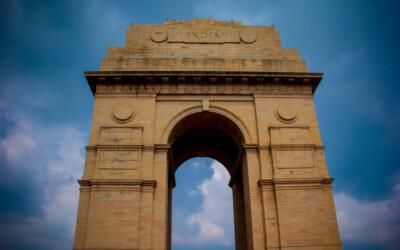Manila is a lively and thrilling destination for digital nomads who want a distinctive experience in Southeast Asia. Its fascinating history, varied culture, and modern infrastructure make it a popular choice for remote workers and digital entrepreneurs.
Table of Contents
- 1 The Visa application
- 2 Cost of living and cost of living arbitrage
- 3 Neighborhoods ideal for digital nomads
- 4 The blockchain and crypto enterprise
- 5 The expat community
- 6 Local nomad job opportunity
- 7 Popular recreational activities and fun spots
- 8 Transportation
- 9 How safe is Manila City?
- 10 Cultural and social norms
- 11 Political and economic stability
- 12 Language and language barriers
- 13 Health Care
- 14 Electrical standards
- 15 Telephone and Internet Plans
- 16 Payment services infrastructure
- 17 Currencies and exchange rates
- 18 Climate and seasons
- 19 Culinary delights
- 20 Common concerns
The city has gained significant popularity as a digital nomad destination in recent years. According to data from Nomad List, a platform that provides information and ratings for digital nomad hotspots, Manila has received a favorable response from its members, with 71% expressing a positive sentiment towards the city, while 29% have reported a negative experience.
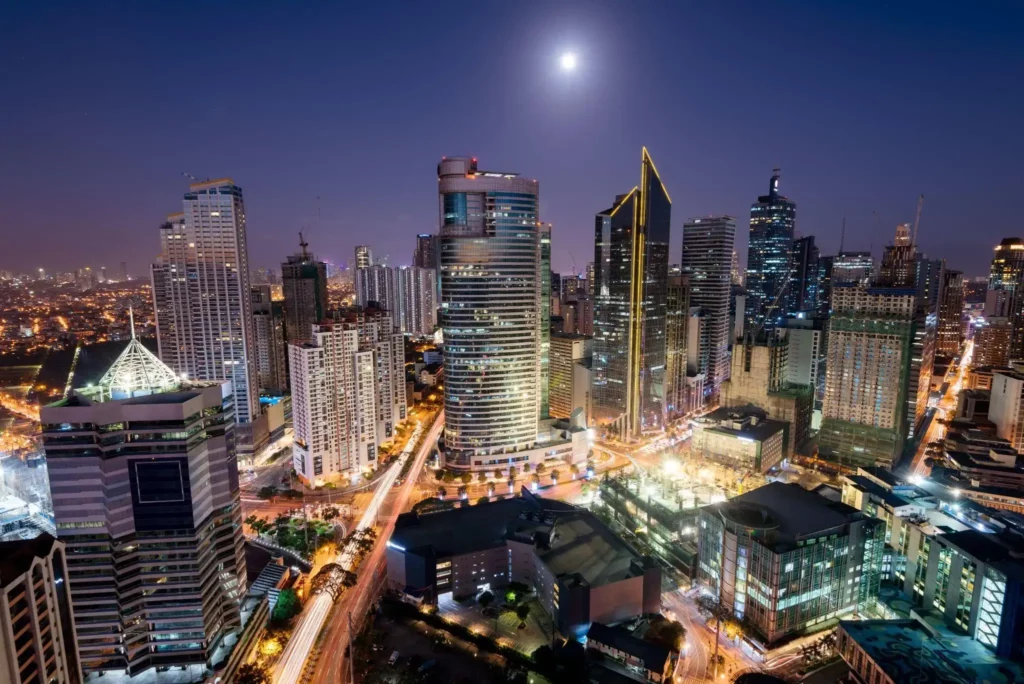
The annual visitor count of 1,320,000 highlights the city’s popularity as a travel destination. This influx of tourists not only adds to the city’s cultural diversity but also creates opportunities for digital nomads to interact with like-minded individuals from around the world. The cosmopolitan nature of Manila ensures that there is always something happening, whether it’s a local festival, international conference, or networking event, fostering a sense of community among digital nomads.
Furthermore, the 15% visitor return rate signifies that a considerable number of people who visit Manila are compelled to return. This high rate of return can be attributed to several factors, such as the warm hospitality of the locals, the affordability of living costs, and the abundance of unique experiences the city offers.
| Key Features | Rating |
| Quality of life score | Okay |
| Cost | Affordable |
| Air quality (annual) | Good |
| Safety | Good |
| Food safety | Good |
| Lack of crime | Okay |
| Power grid | Great |
| English speaking | Good |
| Walkability | Great |
| Nightlife | Good |
| Places to work from | Great |
| Startup score | Okay |
Table source : Nomad List
The Visa application
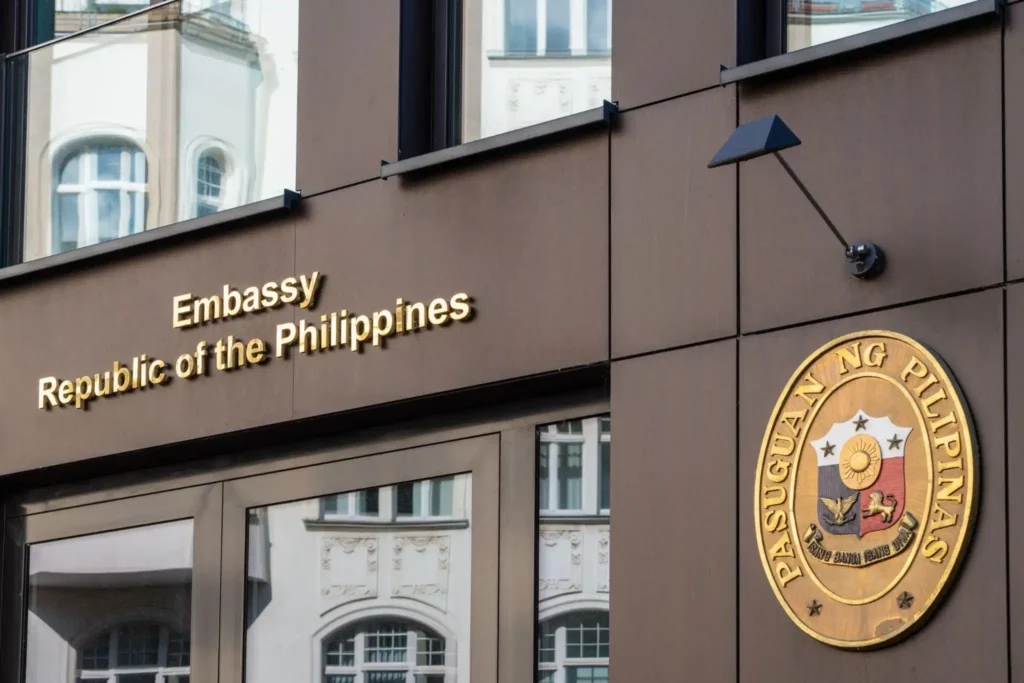
The Philippines provides a range of visa options that are well-suited for digital nomads. Regrettably, the country has yet to introduce the highly acclaimed digital nomad visa that has gained widespread recognition. Nevertheless, given the increasing popularity of this visa category, it is likely that there are plans in progress to introduce it in the near future.
In the meantime, let us discuss some existing visa options for digital nomads.
Non-Immigrant Visas
These types of visas are issued to foreigners visiting the Philippines for a short period of time and do not qualify for permanent residency. They cater to different purposes and circumstances, ensuring that individuals can legally enter and stay in the country based on their specific needs.
The Tourist Visa
One common type of non-immigrant visa is the Philippines Tourist Visa, which is granted to foreigners who intend to visit the Philippines for recreational purposes. This visa allows you to explore the country’s attractions, experience its culture, and enjoy leisure activities during your stay.
The application process
To visit the Philippines as a tourist, it is necessary to obtain a tourist visa. Before submitting your application, it is crucial to identify the specific visa category that aligns with the purpose and duration of your visit. The Temporary Visitor’s Visa (9A) is generally suitable for brief tourism purposes. To ensure compliance with all the essential prerequisites and gain comprehensive knowledge about the various visa options, it is advisable to consult the official website of the Philippine embassy or consulate in your respective country.
The requirements
To get a Philippines tourist visa, you must collect specific documents. Each country has specific requirements regarding these documents. However, some general documents that are typically required include:
- Passport
- Completed application form
- Passport-sized photos
- Proof of travel arrangements
- Proof of accommodation
- Financial documents
- Travel Insurance
If you need to schedule a visa application appointment (Taiwanese nationals don’t need an appointment because they have the online option)
- Reach out to the Philippine embassy or consulate in your country.
- Visit the embassy or consulate for your appointment and submit all required documents and photocopies
- Pay the non-refundable visa fee at the consulate or embassy, depending on your nationality and visa type
- Wait for the embassy or consulate to process your application typically takes several business days. Once your visa is approved, you’ll receive a notification to collect your passport with the visa stamp
Certain locations may provide the service of mailing your passport to your address. To ensure you have recent and accurate information regarding visa requirements, procedures, and fees, you must regularly visit the official website of the Philippine embassy or consulate in your country.
Online Tourist Visa Application
This online visa application, also called Electronic Travel Authorization (eTA), is exclusively available for Taiwanese citizens.
The eTA streamlines the process of obtaining a Philippine Tourist Visa, allowing eligible individuals to obtain authorization to enter the Philippines entirely through online channels. The following steps are involved:
- Visit the official website of the Manila Economic and Cultural Office.
- Complete the designated application form.
- To complete your payment, please use a credit or debit card.
- Upon visa processing and approval, you will receive an email notification regarding the decision.
- When you receive approval for your visa to the Philippines, you can easily print it out and show it to the Immigration Officers when you arrive.
Visa On Arrival
Citizens of all countries are eligible for the Visa on Arrival option except those from approximately 39 countries
| Afghanistan | Egypt | Montenegro | South Sudan |
| Albania | Georgia | Nauru | Sri Lanka |
| Algeria | India | Nigeria | Sudan |
| Armenia | Iran | North Korea | Syria |
| Azerbaijan | Iraq | North Macedonia | Taiwan |
| Bangladesh | Jordan | Pakistan | Timor-Leste |
| Belarus | Kosovo | Palestine | Tonga |
| Bosnia & Herzegovina | Lebanon | Sierra Leone | Ukraine |
| China | Libya | Serbia | Yemen |
| Cuba | Moldova | Somalia |
Simply download this application form and apply
The Business Visa
This one is designed for foreigners entering the Philippines for business-related purposes. This visa is particularly useful for individuals who must attend meetings, conferences or sign business deals with Filipino counterparts. It facilitates their temporary stay in the country while engaging in these professional activities.
Work Visas
Work Visas are available for foreigners who have secured pre-arranged job offers from Filipino companies. They serve as the legal framework for individuals to work in the Philippines temporarily. The document allows foreign workers to contribute their expertise and skills to the local job market.
Difficulties in the Visa Application
The Philippines has specific visa requirements and processes that applicants must adhere to. While the visa application process itself may be simple, there are certain potential difficulties or challenges that applicants might encounter. Let’s discuss a few more common ones.
Documentation requirements
The Philippine visa application typically requires specific supporting documents such as a valid passport, completed application forms, photographs, proof of travel arrangements, financial documents, and potentially additional documents depending on the visa type. The challenge lies in ensuring that all the required documents are gathered and prepared accurately and in the required format.
Lack of information
Finding clear and up-to-date information regarding the visa application process can sometimes be difficult. The official guidelines provided by the Philippine Embassy or Consulate in your country should be the primary source of information, but they may not always be easily accessible, comprehensive, or updated. In such cases, seeking assistance from reliable sources or consulting with visa experts can be helpful.
Lengthy processing times
Visa processing times in the Philippines can vary greatly, and your application may take several weeks or even months to be reviewed. To avoid potential travel planning issues, it’s best to apply well in advance and make appropriate arrangements.
Understanding the eligibility criteria
It helps to know that each visa category has particular eligibility requirements that must be met. For instance, work visas may necessitate a job offer from a Philippine employer, while tourist visas may require evidence of sufficient funds to cover your stay. These criteria can be challenging to fulfill, so it is crucial to thoroughly review the specific requirements for your particular visa category.
Consular interviews
Sometimes, an interview at the Philippine Embassy or Consulate may be necessary to verify your qualifications. It is crucial to prepare thoroughly for this interview by ensuring that all documents and necessary information is readily available. To avoid potential difficulties, carefully review the visa requirements, gather all the required documents, and submit your application much earlier. Seeking guidance and assistance from an immigration lawyer or visa consultant can also be beneficial throughout the application process.
Cost of living and cost of living arbitrage
According to recent Numbeo data, consumer prices in Manila are much lower than in New York – by 61.4% when excluding rent and 71.4% when including it. This means that goods and services such as transportation, clothing, and entertainment are much cheaper in Manila.
Groceries, including fruits, vegetables, and household supplies, are also 62.0% cheaper in Manila.
However, Manila’s lower local purchasing power (75.2% lower than New York) indicates that people in Manila generally earn less than their counterparts in New York.
To keep the living standard costing $9,200 in New York, you would need approximately $2,633.4 in Manila.
Please note that the provided cost estimate is only an approximation, and personal situations and choices may impact the actual expenses.
| Grocery Items | Cost |
| Milk (1 liter) | ₱97.42 ($1.74) |
| Loaf of white bread (500g) | ₱72.96 ($1.30) |
| White rice (1kg) | ₱53.13 ($0.95) |
| Eggs (12) | ₱104.58 ($1.87) |
| Local Cheese (1kg) | ₱371.02 ($6.62) |
| Beef Round (1kg) | ₱410.38 ($7.32) |
| Apples (1kg) | ₱165.09 ($2.94) |
| Tomato (1kg) | ₱87.95 ($1.57) |
Accommodation
Regarding finding accommodation in Manila, there are several factors that you should often consider. These include affordability, safety, access to reliable internet, proximity to coworking spaces, and a comfortable living environment. Fortunately, the city offers various options to meet these requirements.
Serviced Apartments
Serviced apartments are an excellent choice for digital nomads in Manila. These apartments are well equipped and furnished with modern amenities such as high-speed internet, kitchen facilities, and cleaning services.
Popular areas for serviced apartments include
Serviced apartments offer a home-like atmosphere and the flexibility of short or long-term stays.
Co-living Spaces

Co-living spaces have gained popularity among digital nomads due to their community-oriented setup. These spaces provide private rooms, shared accommodations, and communal areas where residents can interact and collaborate with like-minded individuals.
Some well-known co-living spaces in Manila include
Co-living spaces often organize events and activities that foster networking and socializing.
Hotels and Apart-hotels
Many hotels in Manila cater to the needs of digital nomads by offering business-friendly amenities such as high-speed internet, coworking spaces, and meeting rooms. Some hotels even have dedicated floors or sections for long-term stays, providing a comfortable environment for remote work.
Data shared by contributors on Nomad List show that the median monthly rate for a hotel in Manila is $682, making it a suitable option for those seeking an extended stay in the city. A single night’s stay would cost you an average of $32.
Apart-hotels combine a hotel’s convenience with an apartment’s amenities, providing a balance between work and leisure. Popular areas to find hotels and apart-hotels in Manila include Makati, Pasay, and Quezon City.
Airbnb
Airbnb is a reputable platform for finding short-term rentals in Manila. It offers many options, from private rooms in shared apartments to entire homes or condominium units.
Airbnb allows digital nomads to choose accommodations based on their budget, desired location, and specific requirements. According to Nomad List, the median monthly rate for an Airbnb rental is about $1400. You may spend $46 for a single night.
It’s worth noting that some hosts offer discounted rates for longer stays, making it an affordable option for extended periods.
When searching for accommodation in Manila, you should also consider the location’s accessibility to coworking spaces, cafes, restaurants, and other amenities. Before finalizing accommodation arrangements, it’s essential to read reviews, check the reliability of the internet connection, and clarify any specific requirements with the host or provider. Additionally, practicing general safety precautions, such as choosing reputable accommodations, using secure payment methods, and being aware of your surroundings, is crucial when staying in any unfamiliar city.
Neighborhoods ideal for digital nomads
Manila offers several neighborhoods that are ideal for you due to their amenities, convenience, and lively atmosphere. Let’s look at the three areas where you may want to consider living during your stay in the city.
Makati City
Makati is one of the most upscale and cosmopolitan neighborhoods in Manila. It’s known for its modern infrastructure, numerous business centers, and a wide array of coworking spaces, cafes, and restaurants that cater to your needs as a digital nomad. Makati also presents a lively nightlife experience for those who venture out during such times for fun. It hosts the Ayala Triangle Gardens, a popular spot for relaxation and events. The area is well-connected and offers easy access to other parts of Manila.
Bonifacio Global City (BGC)
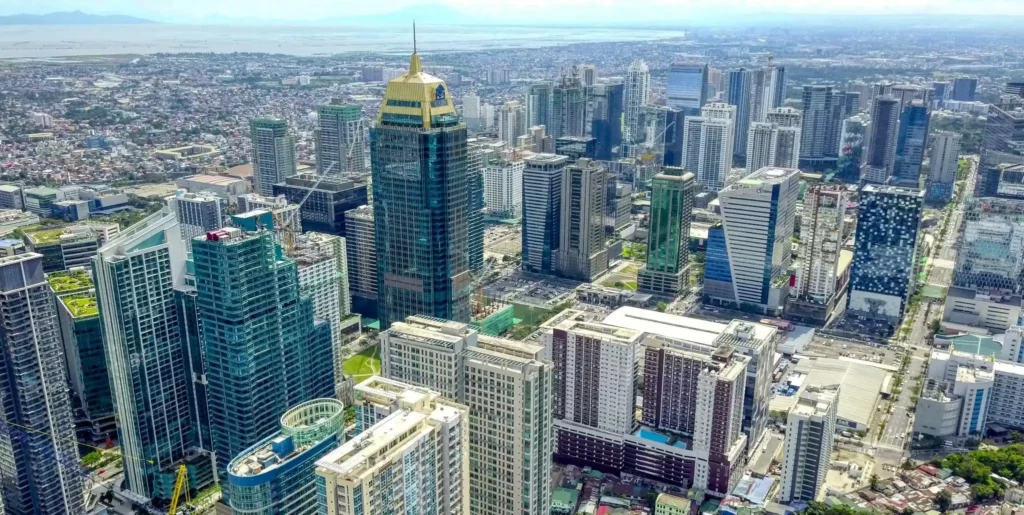
Located in Taguig City, Bonifacio Global City, often referred to as BGC, is a modern and planned neighborhood. BGC is known for its clean streets, spacious sidewalks, and various commercial and recreational establishments. It has a lively atmosphere with numerous cafes, coworking spaces, and high-end shopping malls like Bonifacio High Street and SM Aura Premier. BGC also has several parks and green spaces, making it an ideal neighborhood for digital nomads seeking a balance between work and leisure.
Quezon City (specifically the Eastwood City area)

Quezon City is Metro Manila’ ‘s largest city and offers a mix of residential, commercial, and entertainment options. Eastwood City, located within Quezon City, is a popular neighborhood for digital nomads. It features a modern business district with high-rise buildings that house offices, coworking spaces, and tech companies. Eastwood City also offers an exciting nightlife experience, various dining options, and entertainment joints such as malls and cinemas. The neighborhood is well-connected and provides easy access to other parts of Quezon City and Metro Manila.
These and several other neighborhoods in Manila offer digital nomads a blend of convenience, modern amenities, and a lively atmosphere, making them suitable for remote work while enjoying the local culture and lifestyle. However, before settling for an area, it’s wise to research further and visit these areas to determine the best fit based on your preferences and specific needs.
Utilities
As a digital nomad who probably just landed in Manila, Philippines, it’s essential to clearly understand the utilities you will encounter and their associated costs. Let’s consider some of the utilities you can expect to pay for and their approximate monthly expenses:
Basic Utilities
The basic utilities, including electricity, heating, cooling, water, and garbage services, for an 85m2 apartment will cost you around 6,196.12 ₱ per month. Your cost may differ depending on your apartment’s size and how you use it. Typically, the range can fall between 4,000.00 ₱ and 10,000.00 ₱.
Prepaid Mobile Tariff
You can opt for a prepaid mobile tariff for your local mobile usage, such as making calls or sending messages. On average, one minute of prepaid mobile tariff in Manila costs around 8.21 ₱. The cost per minute may vary slightly, ranging between 6.00 ₱ and 10.00 ₱ depending on the service provider and any available discounts or plans.
Internet cost
As a digital nomad, a reliable and fast internet connection is crucial for your work. In Manila, you can expect to pay around 1,926.37 ₱ per month for internet service. This typically includes a plan with a speed of 60 Mbps or more, unlimited data, and either cable or ADSL connection. The monthly cost for internet service can range from 1,500.00 ₱ to 3,000.00 ₱, depending on the service provider and the specific plan you choose.
Remember that these rates are approximate and may not be the same based on different factors such as location, service providers, and personal usage. It’s advisable to research and compare different options to find the most suitable utilities and providers that meet your needs and budget.
Living as a digital nomad in Manila, you’ll find that these utilities are widely available, and the costs are generally affordable. With a stable electricity supply, access to clean water, and reliable internet connectivity, you can create a comfortable and productive working environment in the city.
In Metro Manila, internet speeds vary depending on the type of connection. Let us examine the city’s mobile and fixed internet speeds based on the data provided by SpeedTest.
Metro Manila Mobile Speeds
- Median Download Speed: 38.96 Mbps
- Median Upload Speed: 7.59 Mbps
- Latency: 18 ms
The median download speed for mobile internet in Manila is 38.96 Mbps, indicating that this is the middle value in a range of download speeds. This suggests that mobile users in the city can expect relatively fast download speeds when accessing content or downloading files. However, it’s important to note that individual speeds may vary based on network congestion and signal strength.
The median upload speed for mobile internet in Manila is 7.59 Mbps. This indicates the median value in a range of upload speeds, reflecting the rate at which users can upload data from their devices to the internet. While the upload speed is lower than the download speed, it is still sufficient for most common online activities like sharing files, uploading images, or sending emails.
The latency of mobile internet in Manila is measured at 18 ms. Latency refers to the time data travels between the user’s device and the server it communicates with. Lower latency values, such as 18 ms, indicate faster response times, leading to a more responsive and seamless online experience, especially for real-time applications like video calls and online gaming.
Metro Manila Fixed Speeds
- Median Download Speed: 94.18 Mbps
- Median Upload Speed: 93.23 Mbps
- Latency: 4 ms
The median download speed for fixed internet in Manila is 94.18 Mbps. Fixed internet connections, such as those provided by wired broadband services, typically offer faster download speeds than mobile connections. With this speed, you can expect quick downloads of large files, smooth streaming of high-definition videos, and seamless online gaming experiences.
The median upload speed for fixed internet in Manila is 93.23 Mbps. Similar to the download speed, the upload speed for fixed internet is also high, allowing you to quickly share files, upload content to cloud services, or participate in video conferences without significant delays.
The latency of fixed internet in Manila is measured at an impressively low value of 4 ms. This indicates minimal delay in data transmission and quick response times when interacting with online services. Low latency is particularly important for applications that require real-time communication or fast data exchange, such as online gaming and video conferencing.
In a sense, the data by SpeedTest suggests that both mobile and fixed internet nomads in Metro Manila can enjoy relatively high-speed connections. Fixed internet offers faster speeds and lower latency than mobile networks, which can benefit bandwidth-intensive activities and applications. However, mobile networks still provide respectable speeds and are convenient for on-the-go connectivity. It’s worth noting that actual internet speeds experienced by users can vary based on various factors, including network conditions, service providers, and the specific location within Metro Manila.
Best Coworking Spaces

Manila has several excellent coworking spaces that cater to the needs of entrepreneurs, freelancers, startups, and remote workers. According to Nomad List, a coworking hot desk goes for about $127 / month. Let’s sample a few that may interest you.
Acceler8 by UnionSPACE
Located in Makati, Acceler8 offers a modern and professionally designed coworking space. They provide flexible membership options, private offices, meeting rooms, and amenities like high-speed internet, printing services, and a pantry area.
Clock In by Ayala Land Offices
This company has multiple branches across Manila, including Makati, BGC, Ortigas, and Vertis North. Their spaces have comfortable workstations, private offices, meeting rooms, and communal areas. Clock In also offers additional services like business support and events.
KMC Solutions
KMC Solutions has several coworking spaces across Manila, including Makati, BGC, Ortigas, and Quezon City. They provide flexible workspace solutions, high-speed internet, meeting rooms, and other amenities. KMC is known for catering to larger teams and corporate clients.
Launchpad Coworking
Situated in Quezon City, Launchpad Coworking offers a comfortable and relaxed workspace. They provide various membership options, including hot desks, dedicated desks, and private offices. Amenities include high-speed internet, meeting rooms, and a pantry area.
These are just some of the coworking available in Manila City. Each space has its own distinct features, amenities, and community. We suggest visiting their websites or taking a physical tour to find the one that’s right for you. That way, you will get first-hand details of what they offer.
The blockchain and crypto enterprise

The Philippines is a lively hub for the crypto and blockchain enterprise! The country has emerged as an exciting destination for various crypto and blockchain initiatives, driven by its dynamic business environment, supportive government regulations, and a growing community of blockchain enthusiasts.
Crypto and blockchain enterprises in Manila actively contribute to developing this technology across various sectors, including finance, supply chain management, healthcare, and more.
Let’s explore some key aspects of the crypto and blockchain ecosystem in Manila:
Startups and Innovation
Manila is home to numerous blockchain startups and innovative projects. These enterprises leverage blockchain technology to solve real-world problems and drive digital transformation. From decentralized finance (DeFi) platforms to blockchain-based remittance services, Manila’s crypto startups are pushing the boundaries of what’s possible.
Notable startups include:
Rebirth Meta Guild
The Rebirth Meta Guild (RMG) are community-centered gaming guilds that invest in NFTs used in virtual economies and blockchain-based games. They invest in both P2E games as well as P&E games, having a concrete differentiator between the two as part of their investment thesis. The guilds utilize a detailed analysis and qualification process, employing investment planning and risk assessment tools/spreadsheets.
The Lucky Panda Guild
The Lucky Panda Guild (LPG), formerly Lucky Panda University, is a spin-off of their group’s digital business. It has evolved into a DAO for its rapidly expanding Play-to-Earn (P2E) activities. As a player-first and community-driven guild, they:
- Onboard, nurture, and support scholars seeking to engage in the P2E economy.
- Optimize player earnings by offering a range of choice activities to maximize return on investment.
- Foster a strong community through active coaching, player management, and the sharing of gameplay strategies and best practices.
FilPass
This startup is dedicated to offering tamperproof technology solutions, aiming to construct a strong, secure, and scalable digital identification and authentication ecosystem. The public and private sectors can leverage this ecosystem to reduce expenses, enhance efficiency, and provide value-added services. By creating a seamless platform, FilPass enables issuing authorities to securely issue verifiable documents while allowing recipients to manage their credential life-cycle through a digital identity.
FilPass, an active AWS Partner Network (APN) member, has established a universal trust framework that enables Filipinos to engage in secure transactions and interactions, whether locally or internationally.
Government Support
The Philippine government has taken progressive steps to foster the growth of crypto and blockchain enterprises. In 2017, the Philippines Central Bank established regulations for virtual currency exchanges through circular no. 944 series. This framework ensures that the industry can operate securely.
The Bangko Sentral ng Pilipinas (BSP) unveiled updated regulations regarding virtual asset service providers (VASPs) conducting operations in the Philippines on January 26, 2021. These guidelines align with the Financial Action Task Force’s standards and impose certain obligations on VASPs. The newly introduced measures necessitate the implementation of anti-money laundering protocols by VASPs, ensuring the detection and reporting of suspicious transactions. Furthermore, VASPs are required to undertake customer due diligence procedures, including.
- the collection of customer identification information
- transaction monitoring
- maintaining comprehensive records
The government’s positive stance towards blockchain technology has attracted local and international players to set up operations in Manila.
Cryptocurrency Adoption
Manila has witnessed a steady increase in cryptocurrency adoption among businesses and individuals. Many merchants in the city now accept cryptocurrencies as a form of payment, allowing residents and tourists to utilize their digital assets for everyday transactions. The convenience and security offered by blockchain technology are driving this adoption trend.
Blockchain Education and Communities
Manila boasts an exciting blockchain community with regular meetups, conferences, and workshops. These events (mainly organized in coworking spaces and related tech hubs) provide industry experts, developers, and enthusiasts a platform to network, share knowledge, and collaborate on innovative projects. Several educational institutions in Manila also offer courses and programs focused on blockchain technology.
Financial Inclusion
One key advantage of blockchain technology is its potential to promote financial inclusion. In Manila, blockchain-powered solutions make financial services accessible to the unbanked and underbanked population. Individuals can securely manage their funds and participate in the global economy through digital wallets and remittance platforms.
How to buy Bitcoin in Manila Philippines
In the Philippines, there are numerous options available for purchasing Bitcoin. Notably, the Bangko Sentral ng Pilipinas (The Central Bank) has granted licenses to several cryptocurrency exchanges. In addition, there are peer-to-peer marketplaces, bitcoin ATMs, and various other services at your disposal. This comprehensive guide aims to assist you in discovering where and how to buy Bitcoin in the Philippines through these different avenues.
Bitcoin ATMs

According to CoinATMRadar, over four Bitcoin ATMs are in Manila, Philippines. These ATMs provide a convenient way for individuals to buy and sell cryptocurrencies. The Bitcoin ATMs in Manila are as follows:
Tivoli Money Exchange, Glorietta 2
This Bitcoin ATM is located at Glorietta 2, a popular shopping mall in Manila. It offers various cryptocurrencies for transactions, including Bitcoin (BTC), Lightning BTC (LBTC), Bitcoin Cash (BCH), Ether (ETH), Dash (DASH), Litecoin (LTC), Zcash (ZEC), Monero (XMR), Dogecoin (DOGE), Tether (USDT), and Ripple (XRP).
Tambunting HQ
Tambunting HQ is another Bitcoin ATM in Manila where you can perform cryptocurrency transactions. It provides the same range of cryptocurrencies as mentioned above, including BTC, LBTC, BCH, ETH, DASH, LTC, ZEC, XMR, DOGE, USDT, and XRP.
UnionBank of the Philippines the Ark – Ayala Insular Branch
This Bitcoin ATM is located at the UnionBank branch known as “The Ark” in Ayala Insular Branch. It offers various cryptocurrencies for buying and selling, including BTC, LBTC, BCH, ETH, DASH, LTC, ZEC, XMR, DOGE, USDT, and XRP.
Others include the
- Willyn Villarica Jewelry
- Montreal Money Changer
- Erus Maerd Money Changer at Newport Mall, Newport World Resorts
The availability of specific cryptocurrencies may vary at each Bitcoin ATM, and it’s recommended to check the machine’s interface or inquire with the operator for the most up-to-date information.
As crypto continues to evolve, Manila remains at the forefront of this technological revolution. With its supportive ecosystem, government initiatives, and a thriving community, The city has the potential to significantly impact the future of blockchain technology locally and internationally.
The expat community
Manila’s vibrant economy, cultural diversity, and tropical climate have made it an attractive destination for expatriates. The expat community in Manila is closely connected, with various networks and organizations facilitating social and professional connections among expats. These networks arrange social events, sports, and cultural gatherings to promote camaraderie.
Unfortunately, determining the precise number of expatriates residing in Manila proves challenging due to the limited availability of such data. Nonetheless, gaining insight into the approximate figures can be achieved through platforms such as social media groups and expat websites like Expat.com and InterNations.
Local nomad job opportunity
Manila offers various remote and local job opportunities for digital nomads.
We shall discuss a few of them
Remote Freelancing
Many digital nomads work as freelancers, providing services in web development, graphic design, content writing, digital marketing, virtual assistance, and social media management. Platforms like Upwork, Freelancer, and Fiverr can connect you with clients worldwide.
Online Teaching
English language proficiency is in demand in the Philippines. You can teach English online through platforms like;
Language centers and online tutoring companies based in Manila also hire remote English teachers.
Remote Customer Support
Various international companies outsource their customer support operations to the Philippines. Look for remote customer support positions with multinational corporations, software companies, or e-commerce platforms.
Remote Software Development
If you have skills in software development, you can work remotely for companies worldwide. Websites like Toptal and Stack Overflow Jobs often offer remote software development opportunities.
Content Creation
Blogging, vlogging, and podcasting have become popular avenues for digital nomads to express their creativity and share their expertise. You can generate your content by displaying advertisements, securing sponsorships, or developing online courses.
Online Consulting
You can offer consulting services remotely if you are an expert in a particular field. This could include business consulting, marketing strategy, financial planning, or career coaching.
E-commerce
Set up an e-commerce website, sell on platforms like Shopify or Etsy, or even leverage social media platforms to reach potential customers.
Remember, digital nomad jobs allow you the freedom to work remotely so that you can consider opportunities beyond Manila. Explore different job boards, freelancing platforms, and networking events to find suitable opportunities for your skills and interests.
Popular recreational activities and fun spots

You’ll find various recreational activities and fun spots in Manila. Let’s highlight some.
Bonifacio Global City (BGC)
This lively district is known for its modern skyscrapers, shopping centers, and trendy dining and nightlife options. BGC offers various recreational activities such as outdoor yoga sessions, jogging or cycling along High Street, and visiting art galleries. While here, you may also consider the city’s buzzing nightlife. It features a mix of upscale bars, clubs, and restaurants. The Fort Strip and High Street are popular destinations within BGC for enjoying drinks, live music, and dancing.
The IMAX theater
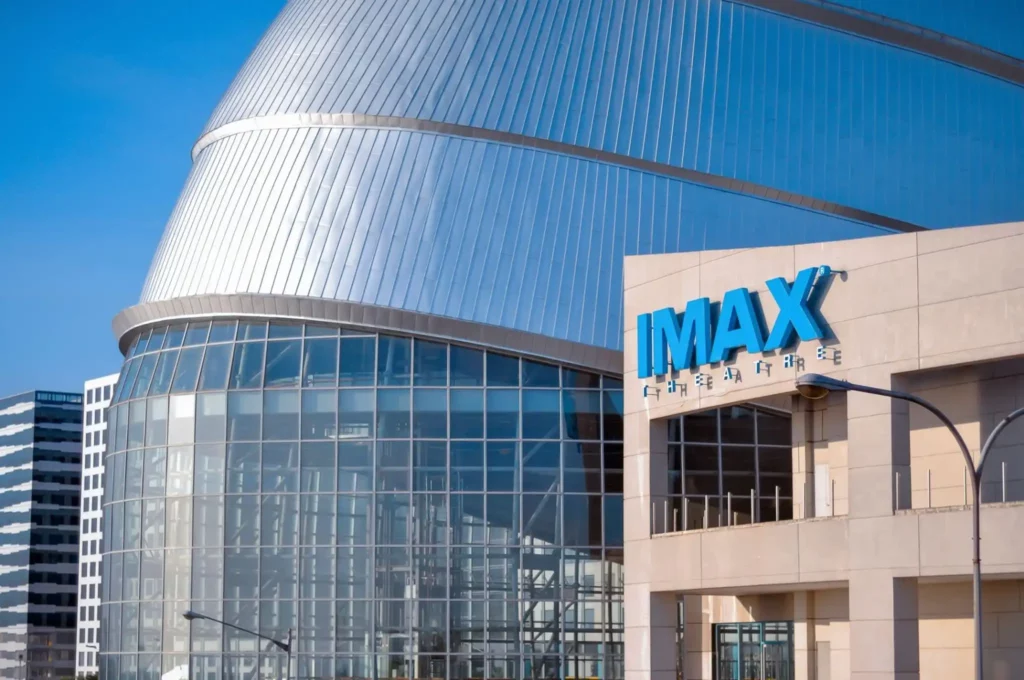
If you are a movie enthusiast, The IMAX theater in Manila offers a truly immersive cinematic experience, bringing movies to life on a larger-than-life screen with advanced audiovisual technology. IMAX is renowned for its giant screens, crystal-clear image quality, and state-of-the-art sound systems, which combine to create an unforgettable movie-watching adventure.
Star City
For thrill-seekers and families, Star City is a popular amusement park in Pasay City. It features a variety of rides, including roller coasters, a Ferris wheel, and water attractions.
Explore the Poblacion District
Poblacion is known as Manila’s hippest neighborhood and a hotspot for nightlife. It offers various bars, clubs, and restaurants catering to different tastes. Head to places like Z Hostel Roofdeck, where you can enjoy drinks while taking in panoramic views of the city.
Check out the local music scene
Manila promises an exciting live music experience, and you can find various venues showcasing talented local artists. Places like the 70s Bistro, Route 196, and Saguijo Bar are renowned for live performances and indie music scenes.
Experience the casino and entertainment complexes
Manila is home to several world-class casinos and entertainment complexes. Resorts World Manila and City of Dreams offer a range of entertainment options, including casinos, live shows, bars, and nightclubs. These venues provide a complete entertainment experience.
Attend themed parties and events
Keep an eye out for themed parties and events happening around the city. From rooftop parties to beach-themed gatherings, Manila hosts various nightlife events catering to different interests. Follow local event organizers and check online platforms for the latest updates.
Discover the speakeasy bars
Manila has a growing trend of hidden speakeasy bars that offer a unique and intimate nightlife experience. These bars often require a password or have discreet entrances, adding an element of adventure to your night out. Popular speakeasy bars include Blind Pig, Finders Keepers, and Exit Bar.
Remember to familiarize yourself with local customs and regulations regarding nightlife activities. It’s also important to prioritize your safety and practice responsible drinking. With its lively atmosphere and diverse offerings, Manila offers plenty of opportunities for digital nomads to enjoy the city’s exciting nightlife.
Transportation
Transportation in Manila is characterized by a diverse mix of air, railway, road, and other means of transport. The city’s transportation network has undergone significant development and expansion over the years to accommodate the growing population and increasing demand for efficient transportation options.
Air Transport
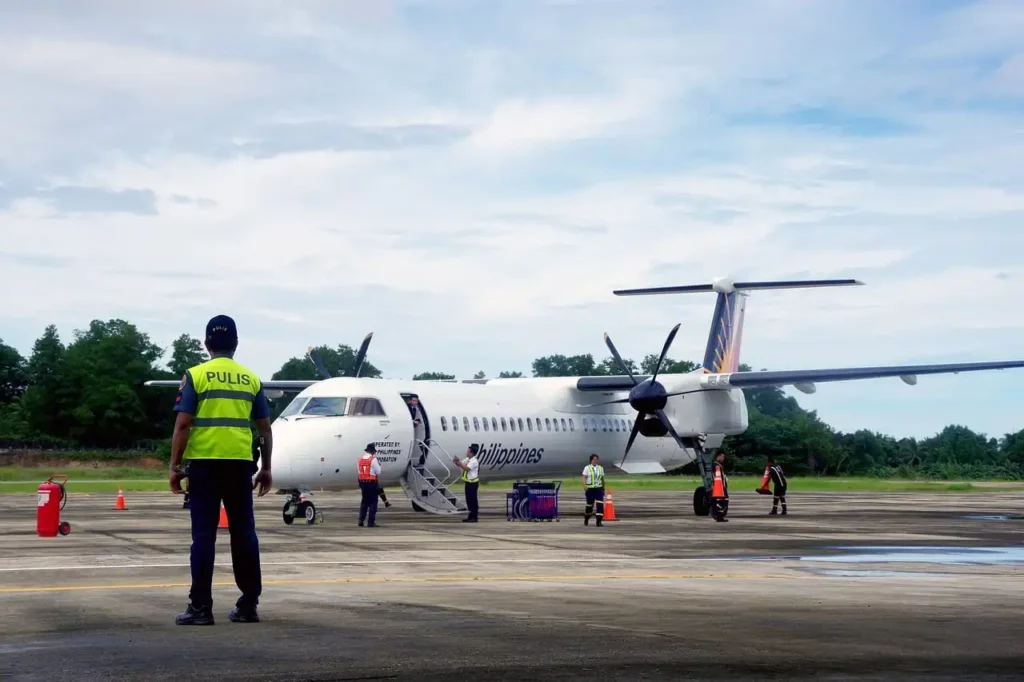
Manila is served by the Ninoy Aquino International Airport (NAIA), which is the main gateway for domestic and international flights.
The distance between NAIA and the city center of Manila varies depending on which part of the city center you are referring to, as Manila is quite large. However, the approximate distance from NAIA to the Manila city center (Rizal Park) is around 7 kilometers (4.3 miles). The actual travel time can vary depending on traffic conditions.
Railway Transport
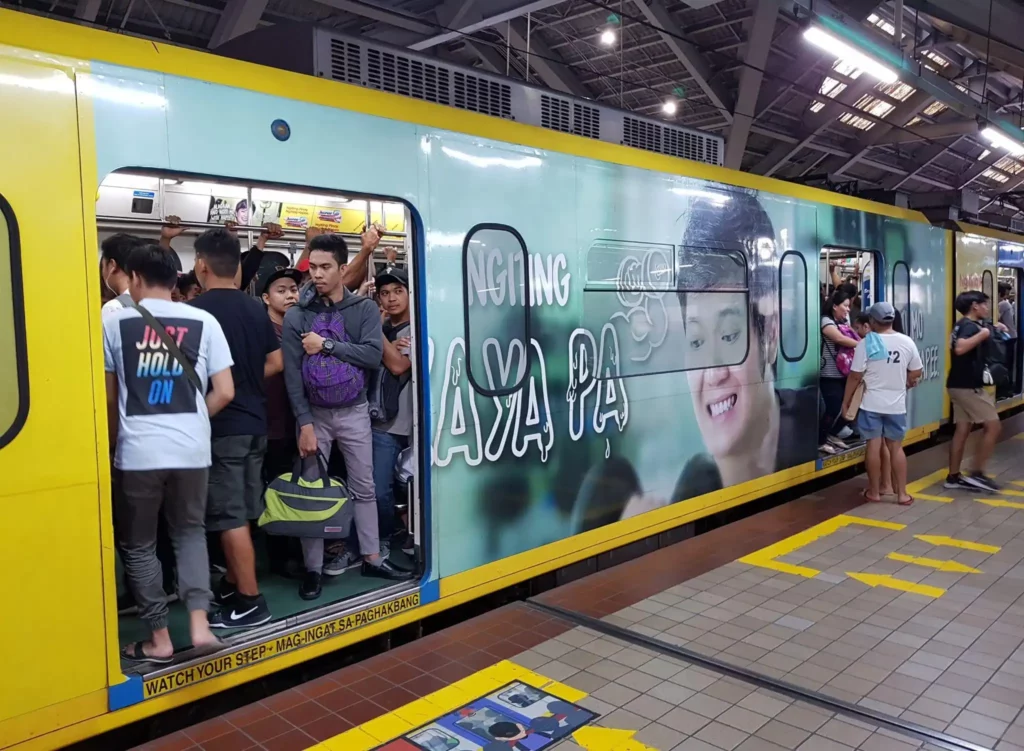
Manila’s railway system is crucial to the city’s transportation infrastructure. Two major lines operate the Metro Manila’s rail network;
Light Rail Transit (LRT)
The LRT consists of two lines, LRT Line 1 (Yellow Line) and LRT Line 2 (Purple Line). LRT Line 1 runs from Baclaran in Parañaque City to Roosevelt in Quezon City, passing through key areas such as Manila’s central business district (CBD) and several major universities.
LRT Line 2 connects Santolan in Pasig City to Recto Avenue in Manila, passing through major commercial areas like Cubao and Araneta Center.
Metro Rail Transit (MRT)
The MRT Line 3 (Blue Line) operates along EDSA, one of Manila’s major thoroughfares. It spans from North Avenue in Quezon City to Taft Avenue in Pasay City, providing a crucial link to various business districts, shopping centers, and government offices.
Road Transport
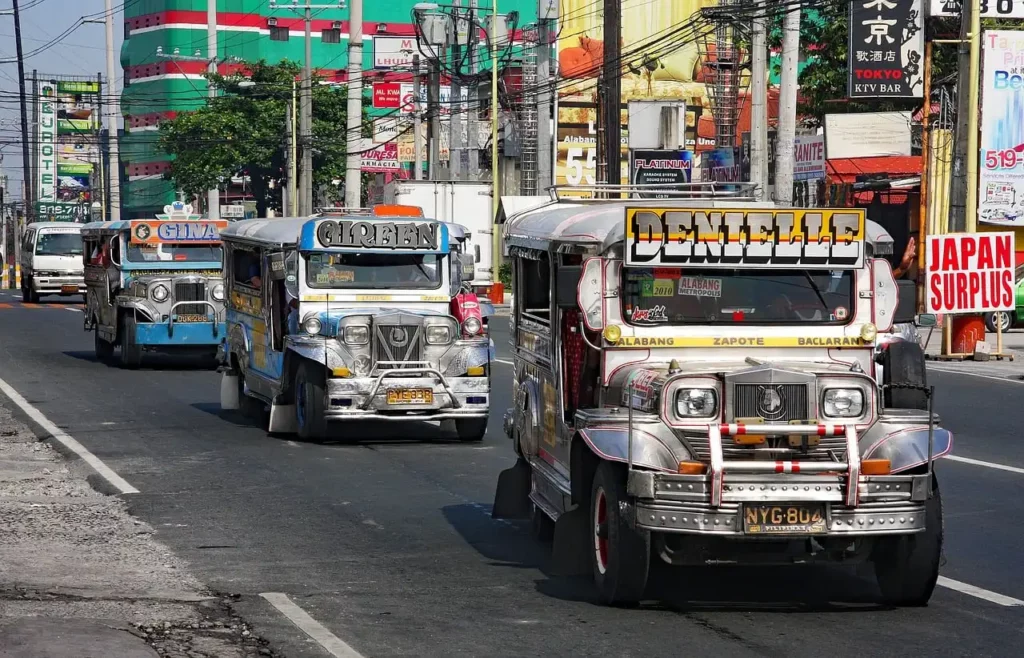
Road transport in Manila is primarily facilitated by buses, jeepneys, taxis, and private vehicles. Buses operate along major routes, offering both air-conditioned and non-air-conditioned options. Jeepneys, iconic vehicles in the Philippines, are a popular mode of transport for shorter distances, often following fixed routes. You can easily find taxis by flagging them down on the street or using mobile apps to book them. Private vehicles are also commonly used, although traffic congestion can be challenging during peak hours.
Other Means of Transport
Apart from air, railway, and road transport, Manila offers additional means of transportation, including;
Tricycles: Tricycles are motorcycle-based vehicles with sidecars, commonly used for short trips within residential areas or small alleys not accessible to larger vehicles.
Pedicabs: Pedicabs are human-powered vehicles, similar to rickshaws, where a cyclist pedals while passengers sit in a small carriage.
Ferries: Manila also has a ferry system, particularly along the Pasig River and Manila Bay, providing an alternative mode of transportation for certain routes.
How safe is Manila City?
If Numbeo’s data for the past 3 years is accurate, then Manila has experienced a significant increase in crime rates, with a concerning rating of 73.20. This indicates a high level of criminal activity. Contributors to this survey have expressed fears of being mugged or robbed, with a worrisome rating of 68.49. The city’s safety concerns extend further, as individuals also express worries about being physically attacked, with a rating of 62.15.
Regarding safety, Manila fares relatively better while walking alone during daylight hours, with a moderate rating of 53.64. However, caution is still advised, as this suggests that certain risks exist. Unfortunately, the situation worsens during nighttime as safety levels decrease significantly to a low rating of 29.58. This highlights the importance of taking extra precautions and vigilance when venturing alone after dark in Manila.
These statistics underline your need to exercise heightened awareness and implement safety measures. It is advisable to avoid isolated or poorly lit areas, especially during nighttime, and to remain alert to one’s surroundings. It also helps to travel in groups whenever possible, as there is safety in numbers. Seeking guidance from locals or authorities regarding safer routes and areas can be wise.
While these crime and safety ratings paint a challenging picture for Manila, it’s essential to remember that personal experiences may vary, and not all areas within the city may be equally affected by crime. Meanwhile, staying informed about the latest safety advisories and being proactive in taking necessary precautions can help mitigate risks and enhance personal safety in Manila.
Like other societies, the Philippines has cultural norms that govern social interactions. To guide you, we will highlight a few significant ones:
- Avoid referring to the woman of the house as ‘hostess’ because it has a negative connotation in the Philippines.
- Removing shoes before entering someone’s home is common practice. The host may offer you slippers to wear inside.
- Leaning on your arms while at the dinner table is considered impolite.
- Gifts are typically not opened immediately upon receipt. Instead, it is common to express gratitude and set the gift aside.
Political and economic stability
Regarding the Political Stability and Absence of Violence/Terrorism indicator, the Philippines obtained a score of -0.92892 in 2021, as reported by the World Bank. This particular indicator reflects the perceptions surrounding political stability and the potential for violence or terrorism driven by political motivations. The score is measured on a standard normal distribution scale from -2.5 to 2.5.
For a digital nomad, the Political Stability and Absence of Violence/Terrorism indicator for the Philippines, with a score of -0.92892 in 2021, suggests a relatively lower level of political stability and a higher potential for violence or terrorism driven by political motivations compared to other countries. The indicator reflects the perceptions surrounding these aspects in the country.
As a digital nomad, it’s important to consider the implications of this indicator.
Please reflect on these few points;
Safety: The lower score indicates that there may be a higher risk of encountering political instability, violence, or terrorism-related incidents in the Philippines. This suggests that as a digital nomad, you should exercise caution and stay informed about the local situation to ensure your safety.
Travel considerations: If you plan to travel to Manila, it’s crucial to research and understand the specific areas or regions where the indicator may have a more significant impact. Some areas within the city might be more affected than others, so assessing the local conditions and taking appropriate precautions is advisable.
Planning and flexibility: The indicator serves as a reminder to plan your digital nomad lifestyle with some flexibility. Stay updated on current events and political developments in the Philippines. With this information, you can make informed decisions about your travel plans and adjust them if necessary to ensure your safety and well-being.
Local support networks: It can be beneficial to establish a network of local contacts, fellow digital nomads, or expatriates who are familiar with the situation in the Philippines. They can provide insights, advice, and support, which can be valuable when navigating any potential challenges arising from the indicator’s implications.
Remember, this indicator represents a perception-based assessment and doesn’t necessarily reflect the actual situation on the ground. It’s essential to gather information from multiple sources and exercise your judgment while making decisions related to your digital nomad lifestyle.
Recent economic performance
A report published on the Philippine Statistics Authority website shows that in the initial quarter of 2023, the Philippine economy witnessed a growth of 6.4 percent in its Gross Domestic Product (GDP), with the primary drivers being
- Wholesale and retail trade, including the repair of motor vehicles and motorcycles, is at 7.0 percent.
- Financial and insurance activities demonstrated a growth rate of 8.8 percent. Additionally, other services recorded a significant growth rate of 36.5 percent.
- Agriculture, forestry, fishing, industry, and services registered 2.2, 3.9, and 8.4 percent growth, respectively.
For a digital nomad interested in working from Manila, the Philippine Statistics Authority website report provides valuable information about the country’s economic performance in the initial quarter of 2023.
Here’s what the report could mean for you as a digital nomad:
Economic Growth
The 6.4 percent growth in the country’s Gross Domestic Product (GDP) indicates a positive economic climate in the Philippines. This growth suggests that the overall business environment is expanding, which can lead to increased job opportunities and a higher demand for goods and services.
Opportunities in Wholesale and Retail Trade
The 7.0 percent growth in wholesale and retail trade, including the repair of motor vehicles and motorcycles, indicates a thriving sector. As a digital nomad, you may find opportunities to collaborate with or provide services to businesses in this sector, such as e-commerce platforms or retail companies.
Language and language barriers
The Philippines boasts several languages and dialects, with the constitution recognizing Filipino and English as the official languages. Moreover, there are many significant regional languages spoken throughout the country.
The Philippines has consistently demonstrated commendable English proficiency on a global scale, as indicated by its ranking of 22 out of 111 countries in terms of English language skills. This achievement is further reinforced by the country’s EF English Proficiency Index (EPI) score of 578, surpassing the global average of 502. Such figures highlight the Philippines’ remarkable competency in the English language.
In the Asian context, the Philippines stands out prominently, securing the second position out of 24 countries regarding English proficiency. This remarkable standing in Asia further reinforces the country’s reputation as a hub for English language education and proficiency.
The high English proficiency in the Philippines has numerous advantages for the country. It strengthens the Philippines’ position as a global outsourcing destination, attracting international businesses that require English-speaking talent. Additionally, it enhances the employability of Filipinos, both locally and internationally, as many companies across the globe value employees with strong English language skills.
This, then, means that there are minimal language barriers, particularly for digital nomads coming in from English-speaking backgrounds.
Health Care
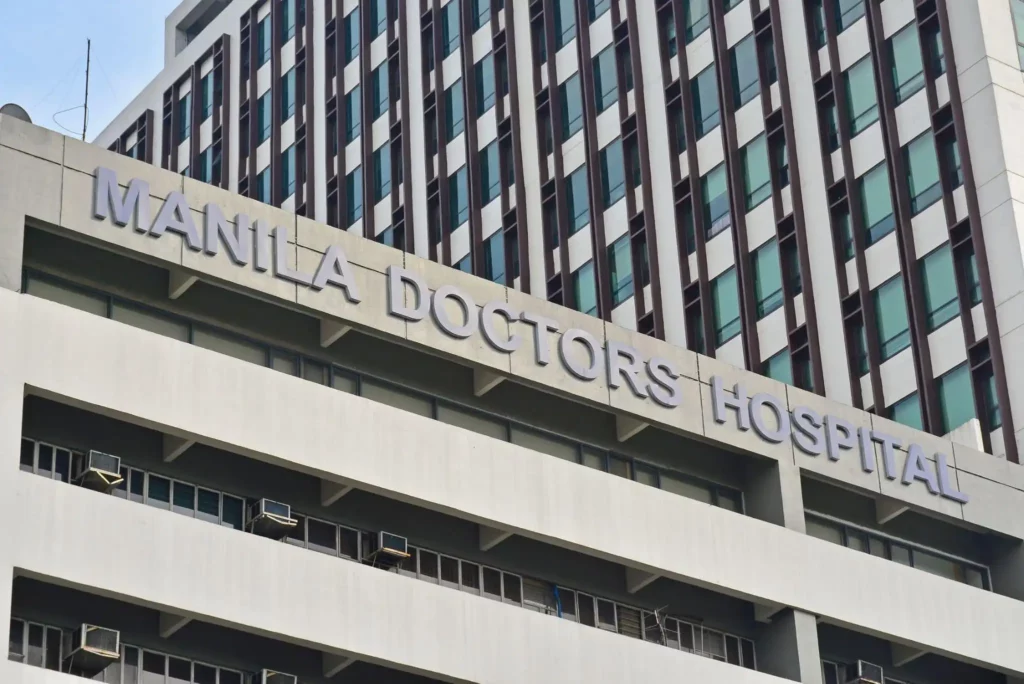
The Philippines’ Global Health Security (GHS) Index Country Profile shows that Manila has an overall health index score of 45.7. This score reflects how ready and able the country is to handle health emergencies and pandemics. A higher score means better health security.
In the same survey, the country is ranked 57 out of 195 countries in terms of health security. This ranking provides a comparative assessment of the country’s performance in relation to other nations. A higher rank indicates a relatively better health security position.
More recent research by numbeo involving 69 contributors painted a rosier picture of the Philippines’ health sector owing to the impressive scores registered in the surveyed aspects.
For example, the skill and competency of the medical staff aspect registered 68.01%, indicating a high level of satisfaction. This suggests that visitors perceive the medical staff in Manila to be knowledgeable and competent in providing healthcare services.
The sector’s speed in completing examinations and reports garnered about 60%, indicating a moderate level of satisfaction. Such a score suggests that there may be room for betterment regarding the efficiency and timeliness of completing examinations and generating reports.
The satisfaction level for the availability of equipment for modern diagnosis and treatment is reported to be 67.69%, indicating a high level of satisfaction. This implies that visitors perceive healthcare facilities in Manila to be adequately equipped with modern diagnostic and treatment tools.
The Philippines’ healthcare system
The healthcare system in the Philippines operates through a combination of private and public sectors, with the Department of Health overseeing the public care system. Public healthcare is governed by the Universal Health Care (UHC) system, administered by the Philippine Health Insurance Corporation (PhilHealth), a government-owned entity.
Under the UHC system, both citizens and expatriates are covered by a national insurance scheme. This scheme is funded through a combination of municipal and government funds and contributions from employers and employees.
Private healthcare services and private insurance options are also available in the Philippines for those who can afford them. However, for most locals, these private options typically supplement the public scheme.
Does a digital nomad need health insurance?
All legal resident expatriates, including eligible digital nomads in the Philippines, must enroll in public insurance through the Philippine Health Insurance Corporation (PhilHealth). Mandatory registration can be done either in person at any local PhilHealth office or online.
There are two ways to get health insurance coverage. You can enroll in the PhilHealth public health insurance scheme or purchase private expat health insurance.
Ideal hospitals for digital nomads
Healthcare facilities in the Philippines, especially those in Manila, commonly provide top-notch medical services. Let’s sample two facilities.
The Medical City Hospital
The Medical City (TMC) is a renowned hospital in Manila, Philippines. Recognized for its exceptional healthcare services, TMC is a leading institution dedicated to delivering high-quality medical care to patients.
With state-of-the-art facilities and a commitment to innovation, the hospital offers various specialized medical services, including cardiology, oncology, neurology, orthopedics, and more.
TMC is equipped with advanced medical technology and a team of highly skilled healthcare professionals, ensuring comprehensive and personalized care for each patient.
St. Luke’s Medical Center
St. Luke’s Medical Center, located at 32nd St. Bonifacio Global City, Taguig City, Philippines, is a premier healthcare facility. Since its establishment in 1982, the hospital has expanded its services to include various specialties. These are;
- Dental
- Internal Medicine
- Ophthalmology
- Psychological care
The facility is committed to delivering world-class treatment and ensures that international patients receive exceptional care from highly skilled physicians and staff. Their expertise and attention to detail guarantee that every patient receives personalized and comprehensive medical management.
Vaccinations
As you plan to tour and vacation in the Philippines, it’s important to get all your routine vaccines done beforehand. There are also specific vaccines that are recommended for travelers to protect against certain diseases. The Centers for Disease Control advises that you visit your doctor at least a month before your trip to discuss and receive any necessary vaccines or medications.
Let’s consider some of the mandatory vaccines you need to take before this trip.
- Routine Vaccines
- COVID-19
- Measles-Mumps-Rubella (MMR)
- Flu (influenza)
- Chickenpox (Varicella)
- Diphtheria-Tetanus-Pertussis
- Polio
- Shingles
Cholera: recommended for children and adults traveling to areas with active cholera transmission.
Hepatitis A: recommended for unvaccinated travelers aged one year or older going to the Philippines. This vaccine should also be given to infants 6-11 months old, with the dose not counting toward the routine 2-dose series.
Hepatitis B: recommended for unvaccinated travelers of all ages.
Japanese Encephalitis: Japanese encephalitis vaccine is recommended if you plan to tour areas with Japanese encephalitis or spend long periods there.
Malaria: Consult with your doctor to determine the appropriate malaria medication and start taking it multiple days before your trip, during your stay, and after your return.
Measles: Infants aged 6 to 11 months traveling internationally should receive one dose of measles-mumps-rubella (MMR) vaccine before travel.
Rabies: Rabies is present in dogs in the Philippines. If you will likely be exposed to dogs or wildlife during your trip, consider rabies vaccination before departure.
Typhoid: The typhoid vaccine is recommended, especially if you plan to visit smaller cities or rural areas.
Electrical standards
The standard voltage in Manila and throughout the Philippines is 220-240 volts. The commonly used plug types in the country are Types A, and B. Type A plugs consist of two flat parallel pins with no grounding, while Type B plugs have an additional grounding pin. These plug types are similar to those found in Canada, the United States, and other countries.
To ensure compatibility with different outlets, it is recommended to carry a universal adapter that supports Type A and Type B plugs. Although different outlet shapes are available, the most common ones in the Philippines are Type A and Type B,
Carrying a universal adapter with multiple socket types is always a wise decision, as it allows you to accommodate any variations you may encounter during your travels.
Telephone and Internet Plans
As a digital nomad in Manila, you have several options for telephone and internet plans to meet your connectivity needs.
For example, the Philippines has several mobile network providers offering prepaid and postpaid plans. The most prominent ones are
They offer a range of plans with various data allowances, call and text packages, and additional features.
You can visit their websites on the above-provided links or physical stores to explore the plan that suits your requirements.
Payment services infrastructure
The payment services infrastructure in Manila has undergone significant advancements in recent years, driven by technological innovations and increasing digitalization. Manila, being the capital city and one of the major economic hubs of the Philippines, has witnessed the rapid development of a robust payment ecosystem that caters to the diverse needs of businesses and consumers.
Mobile payment
Mobile payment solutions have gained popularity in Manila, with many Filipinos embracing digital transactions. Mobile wallets, such as GCash and PayMaya, have emerged as leading players, enabling users to make payments, transfer money, and even pay bills using their smartphones. These mobile wallets often integrate with traditional banking systems, making it convenient for users to link their accounts and access a wide range of services.
Online payment methods
The rise of e-commerce has significantly impacted the payment landscape in Manila. Online marketplaces like Lazada and Shopee have become prominent platforms for businesses and consumers, fostering demand for secure and efficient online payment methods. These platforms often offer multiple payment options, including credit/debit cards, bank transfers, and cash on delivery, ensuring flexibility for customers.
Online banking solutions
In addition to mobile and online payment solutions, traditional banking institutions in Manila have also adapted to the population’s evolving needs. Most banks provide mobile and online banking services, allowing customers to perform various transactions through web portals or dedicated mobile apps. These services include fund transfers, bill payments, and balance inquiries. Automated Teller Machines (ATMs) are widely available throughout the city, ensuring convenient access to cash and basic banking services.
Currencies and exchange rates
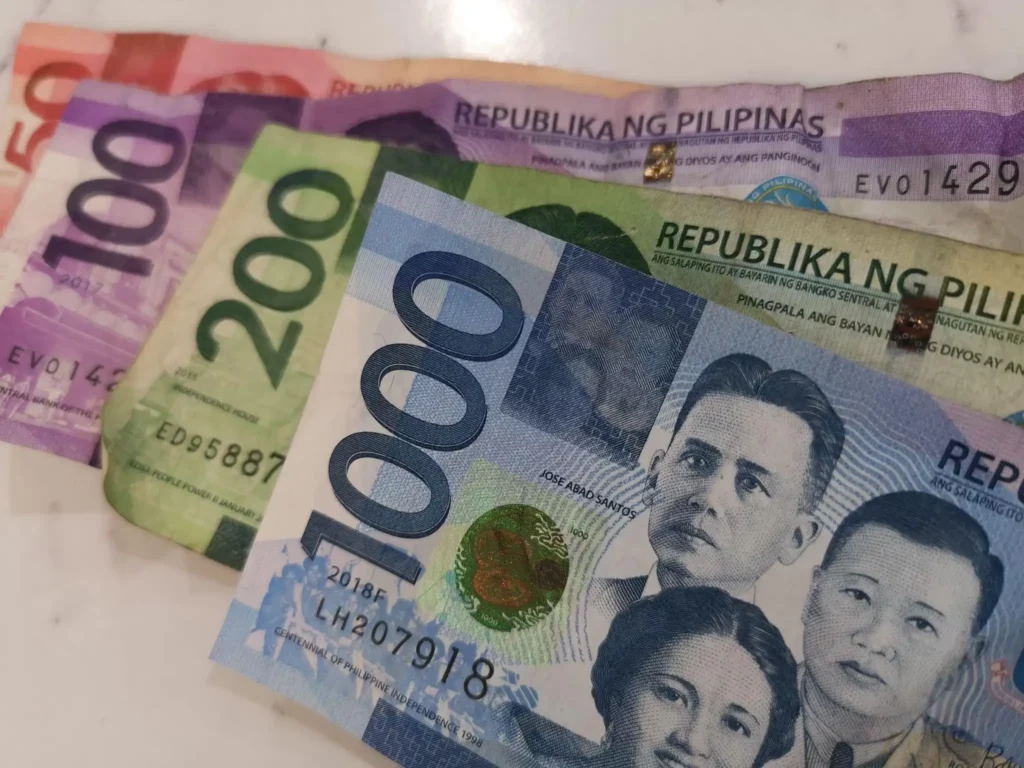
The legal tender of the Philippines is the Philippine peso (PHP), which serves as the country’s official currency. The Philippine Central Bank issues and regulates the currency.
The Philippine peso is subdivided into 5-peso, 10-peso, and 25-peso coins, while banknotes are available in denominations of 20 pesos, 50 pesos, 100 pesos, 200 pesos, 500 pesos, and 1,000 pesos. These banknotes feature important figures in Philippine history and landmarks of the country.
Exchange rates can be obtained from banks, financial institutions, or foreign exchange dealers. Online platforms and currency exchange booths in airports also provide exchange services. The rates offered by different institutions may vary slightly due to factors such as transaction fees and commissions.
You are strongly advised to exchange currency at reputable establishments to ensure fair rates and avoid counterfeit currency. Please note that the exchange rates for cash transactions may differ from those for electronic transfers or credit card payments.
Climate and seasons
Manila experiences a tropical monsoon climate with two seasons: dry and wet. It is dry from November to April, typically featuring warm, sunny, and low humid conditions. Temperatures during these months are roughly 27-30 degrees Celsius.
Without any doubt, this is the season tourist troop the beeches to engage in outdoor activities.
The period of increased precipitation, known as the wet season, sets off in May and extends through October. This timeframe is marked by frequent rainfall, elevated humidity, and intermittent thunderstorms. Notably, the months of July and August witness the greatest amount of rainfall. Temperature-wise, the range during this season typically fluctuates between 25 and 29 degrees Celsius (77-84 degrees Fahrenheit).
It helps to acknowledge the possibility of typhoons during this period, which can bring about intense downpours and strong gusts of wind. The transitional months, particularly May and October, may exhibit some weather variability, with a combination of both sunny and rainy days as the seasons transition.
| Month | 1 | 2 | 3 | 4 | 5 | 6 | 7 | 8 | 9 | 10 | 11 | 12 |
| Av Temp (°F) | 78 | 80 | 82 | 84 | 85 | 82 | 82 | 81 | 82 | 82 | 81 | 79 |
| Av Rain (mm) | 10 | 10 | 10 | 20 | 60 | 90 | 120 | 140 | 110 | 80 | 50 | 20 |
Culinary delights

Manila is a food paradise famed for its culinary delights. The city offers a range of delicacies that showcase the country’s rich culinary heritage. Although it offers tens of mouthwatering dishes, we shall only discuss three leading options you must sample while there;
Adobo
While in Manila, trying Adobo is a must. It is a flavorful and savory dish made by marinating meat, typically pork or chicken, in a mixture of vinegar, soy sauce, garlic, and spices. The marinated meat is then slowly simmered until tender, allowing the flavors to meld together. The result is a deliciously tangy and savory dish with a hint of sweetness. Adobo is often served with steamed rice and is best enjoyed with a side of pickled vegetables. It is a true Filipino comfort food and a culinary masterpiece embodying the Philippines’ flavors.
Lechon
This famous Filipino delicacy is often the centerpiece of grand celebrations and special occasions. It is a whole roasted pig marinated with a blend of spices and seasonings, then cooked slowly over an open fire until the skin turns golden and crispy while the meat remains tender and succulent. The result is a dish with a perfect balance of flavors, with the crispy skin providing a delightful crunch and the well-seasoned meat offering a rich and savory taste. Lechon is typically served with a liver sauce made from the drippings of the roasted pig, along with steamed rice. It is a true indulgence and a must-try delicacy when in Manila.
Halo-halo
While this may sound like a greeting, “halo-halo” literally translates to “mix-mix” in Tagalog, which perfectly describes the dish. It consists of a colorful assortment of ingredients layered in a tall glass, creating a delightful medley of flavors and textures. Typical components include sweetened fruits like bananas, jackfruit, beans, jelly cubes, tapioca pearls, and sweetened yam or sweet potato. Crushed ice is generously added to the mix and then topped with evaporated milk and leche flan (caramel custard). Most people enjoy it on hot summer days as a refreshing treat. The combination of ingredients in halo-halo provides a delightful burst of flavors and textures, making it a beloved dessert in the Philippines.
Common concerns
If you are always on the Nomad List website like me, you must have read the pros and cons of being in Manila as a digital nomad. The concerns raised by digital nomads on Nomad List regarding various aspects of their experiences can be subjective and influenced by individual perspectives. While some contributors may have genuine concerns based on their personal encounters, evaluating these issues in a broader context is important to understand whether they are widespread or representative of the overall situation.
Consider the concern about “Not much to do,” for example. The perception of “not much to do” can be highly subjective and dependent on individual interests and expectations. While some destinations may have limited recreational or entertainment options, many places cater to various activities and experiences. You must conduct thorough research and identify destinations that align with your preferred lifestyle and interests. Engaging with local communities and exploring cultural offerings can uncover hidden gems and enhance the overall experience.
What about the one about slow internet? Well, Internet speed can vary greatly depending on the country, city, and even the specific location within a city. While some places may indeed have slower internet speeds compared to others, this concern may not be universally applicable. Many popular digital nomad destinations have significantly improved their internet infrastructure in recent years, providing reasonably fast and reliable connectivity. To make informed decisions, it’s important to thoroughly research the internet options available in your specific location.
Road quality and traffic congestion (though not listed on Nomad List) pose significant challenges worldwide, and Manila is no exception. A study conducted by a UK financial services platform in early 2022 revealed that the Philippines featured among the top 10 countries with the “worst quality roads,” scoring only 44.8 out of 100. If we assume the survey was conducted accurately and impartially, this data should raise genuine concerns for digital nomads planning to relocate to Manila
We could analyze the entire list, but these two are certainly enough to build your confidence about Manila. That said, you may proceed with your travel plans, and please take care as you have all the fun Manila Philippines has to offer!
Always check with local country websites for the most up to date visa, health, tax and travel requirements before entering a country. This article is general information and does not constitute legal advice, check with a legal professional for visas, working visas, applicable tax and crypto laws specific to you.



